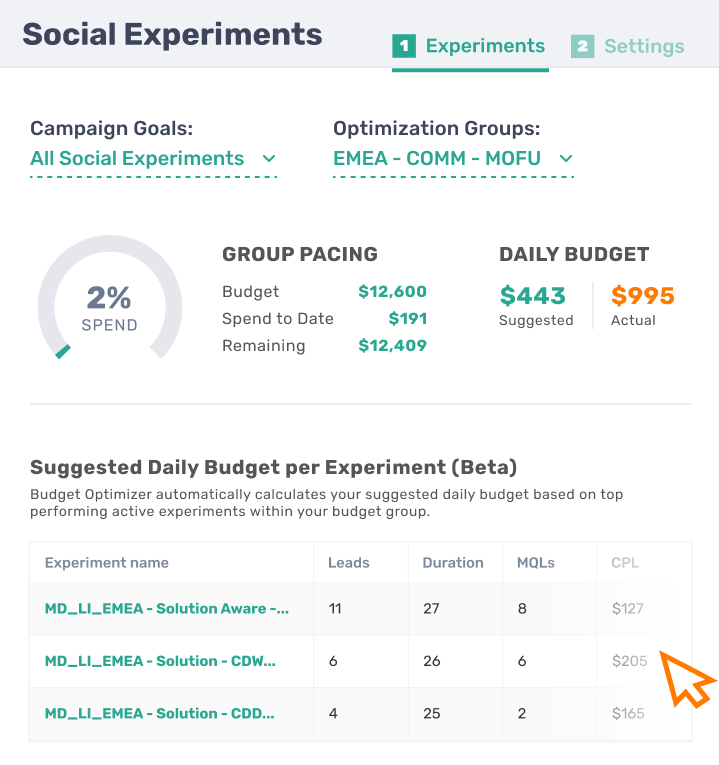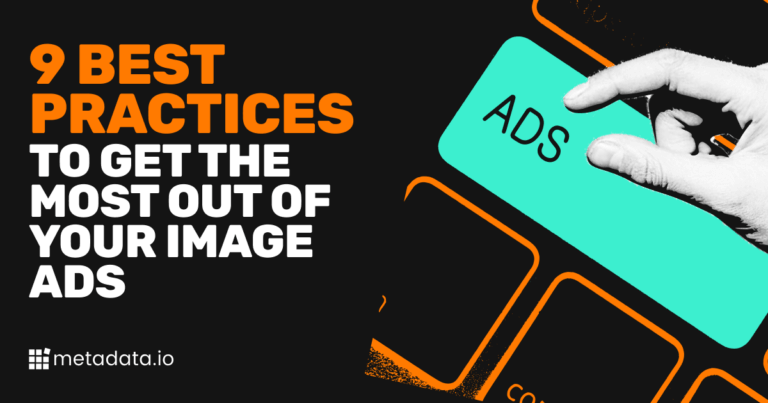When Do DIY Paid Campaigns Make Sense?
Almost never. Am I biased? Sure, but I genuinely believe that.
Maybe—and I mean maybe—it makes sense to DIY your campaigns in native ad channels if you’re new to running paid ads, working with a smaller budget, or have a marketing plan without many moving parts.
If that’s the case, manually running paid campaigns could make sense.
But the instant you dig back into your wallet, introduce new ad types, run experiments, and expect optimization across channels, DIY won’t cut it.
You need a better way.
In this article, we’ll explore the pitfalls of native ad channels, why they’re more detrimental than ever, and how Metadata can help you maximize your ad budget in 2023.
The problem with native ad channels
You can run ads natively on Facebook, LinkedIn, and Google.
Facebook, which now has nearly 3b monthly active users (MAUs), introduced ads years ago. So long ago that Blockbuster was one of its “landmark partners.”
Mark Zuckerberg said, “Facebook Ads represent a completely new way of advertising online. For the last hundred years, media has been pushed out to people, but now marketers are going to be a part of the conversation. And they’re going to do this by using the social graph in the same way our users do.”
We’ve come a long way since then, but native channels remain at the heart of the advertising world. TikTok, which rose to fame during the pandemic, launched its self-service ad platform in 2020.
Native ad channels still serve their purpose, mostly for advertisers with a limited budget and simple campaigns, but their pitfalls are too deep to ignore.
Understanding the campaign structure in native ad channels
Here’s the problem: Native ad channels put almost all of the onus on demand gen marketers—you know, humans.
As powerful as these channels can be, they require bandwidth and brain power.
Here’s a high-level overview of how Facebook, LinkedIn, and Google structure campaigns:

The box on the left is your campaign and budget. That $100/day tells the native ad channels to run your ads until you reach that threshold. When they get there, the campaign stops and restarts the next day.
Your audiences are who’ll see the creatives/ads—for example, director-level employees at Fortune 500 companies or people who follow your LinkedIn page.
From a high level, this is how campaigns work. Unfortunately, that structure is also where they go wrong.
In the example, you have three audiences and three ads, which means you have nine combinations.
The problem is, you can’t see which combinations are driving pipeline.
Why? Because your budget sits at the campaign level, preventing you from isolating the variables and identifying your highest-performing combinations.
A nightmare for demand gen marketers
Without the ability to drill down into the campaign, optimizing for performance and efficiency is impossible. But that doesn’t stop demand gen marketers from trying (or the leadership team asking them to work miracles).
The path to a miracle is long, cumbersome, time-consuming, and requires a level of Excel mastery even Bill Gates would envy. It’s dark, too.
Despite the marketing world’s push for transparency, demand gen marketers still largely operate in a black box when they run campaigns natively.
The only light available requires formulas, hours of repetitive work, and even more patience. This level of complexity and nuance is enough to keep many demand gen marketers at bay.
For those willing to dig in, the analysis is often too high to lead to meaningful optimizations; there’s only so much time in the day.
Imagine having to open Excel every morning, run formulas, deduplicate the data, make sense of it all, and adjust daily budgets in native ad channels just to make sure you’re on track. Now do that across Facebook, LinkedIn, and Google.

This is the complex reality of anyone manually running their own campaigns, but there’s also a human element. Budgets are mismanaged. Pacing goes haywire.
Ask any demand gen marketer if they’ve messed up pacing and not spent their budget evenly throughout the duration of the campaign.
Every one of them will say yes. If they say no, they haven’t been in the industry long enough. The opportunities for error are endless.
That’s a problem during ordinary times, but in a down economy, it’s a recipe for disaster, wasted ad spend, and a serious closed-door conversation with the leadership team.
Times are tough and marketing budgets are under pressure, despite evidence pointing to the fact that upping budgets during a downturn is a savvy move.
According to the Analytic Partners report, 60% of brands that increased spend in the last recession saw greater ROI, while those that spent more on paid ads saw a 17% increase in incremental sales.
Marketing teams can’t afford to misspend their demand gen budget. Embracing a do-it-yourself approach to running campaigns all but guarantees that will happen.
Why Metadata offers a better way
We’ve talked about how Metadata separates itself from native ad channels before. In that article—you can read it here—we talked about targeting, automation, experimentation, and optimization.
For example—when you run campaign experiments with Metadata, you can answer key questions like:
- Which audiences should I target with my budget?
- Does a specific offer type create pipeline more efficiently?
- Is Google, Facebook, or LinkedIn generating the best results for me?
You can’t answer these questions on Facebook, Google, or LinkedIn.
Remember: Your budget sits at the campaign level, meaning you can’t get the level of granularity required to answer the nitty-gritty questions that influence whether your campaigns are generating pipeline and revenue.
But there’s more to Metadata.
I’m talking about Optimizer, our proprietary technology that makes sure campaigns pace evenly and spend in the smartest way possible to drive the most revenue—whether your campaigns live on Facebook, LinkedIn, Google, or Display.
Pacing and optimization with Metadata
Let’s take a step back. What does campaign implementation, pacing, and optimizing look like in native ad channels?
Let’s build a super high-level media plan:
- Goal: Demos
- Total budget: $10k
- Campaign flight: 30 days
- Daily spend: $333
Now, consider you have five campaigns using different targeting audiences, creatives, etc.
After you build these campaigns natively, the work is just getting started, especially from a pacing, and optimization standpoint.
Not only did the demand gen marketer have to build and rebuild the same five campaigns in every channel, a huge time suck and painfully repetitive, but they had to watch pacing like a hawk and manually optimize accordingly.
Every morning, they have to log into each channel and see if they’re on track to spend that $10k as evenly as possible. Then, they need to figure out which campaigns perform best and optimize the daily budgets to drive the most cost-efficient demos.
If the 30-day campaign has a budget of $10k, demand gen marketers would have to spend (roughly) $333 a day. But they can’t just divide that across active campaigns—they have to divvy it up according to performance.
So, maybe:
- Campaign #1: $120
- Campaign #2: $75
- Campaign #3: $50
- Campaign #4: $70
- Campaign #5: $18
Campaign #1 gets the most ad dollars that day because it’s driving the most cost-efficient demos. Meanwhile, Campaign #5 only gets a few because the demos cost a fortune.
The demand gen marketer has to do this manually in every native channel, every single day.
This is time-consuming, but it also opens the door to human error, which makes over-, and underspending an all-too-common inevitability. As powerful as these channels are, they lack the control demand gen marketers need to spend efficiently and effectively.
They also don’t allow demand gen marketers to optimize for what they care about, e.g., MQLs, triggered opportunities, influenced opportunities, etc.
Instead, they optimize based on cost because that’s all native ad channels show. Optimizations are made without “quality” in mind.
With Metadata, demand gen marketers can not only pace correctly, but also optimize toward the metrics that matter—and they can do it across channels with just a click.
Understanding the ROI of Metadata
We’re in the year of efficiency.
Amy Weaver, President and CFO of Salesforce, alluded to efficiency in the company’s Q4 earnings call when she said, “Our relentless focus on execution and proactive management of the current environment allowed us to close out a strong quarter and set us up for a transformational fiscal year 24. It’s a New Day at Salesforce, and as we look ahead, I am excited for the opportunity in front of us as we continue to drive profitable growth.”
That “profitable growth” requires efficiency and completely abandoning a “grow-at-all-costs” mindset.
Not convinced? Mark Zuckerberg called 2023 the “Year of Efficiency” for the social media giant.
And efficiency is at the heart of the ROI of Metadata. Think back to building, launching, and optimizing campaigns in native ad channels.
Doing it all correctly requires countless hours, thick skin, and a few prayers. And even if the demand gen marketer does everything to stay on track, it’s guaranteed they’re leaving efficiency and performance gains on the table.
Why?
- No one is perfect, and everyone makes mistakes. That’s a given with anything manual, but even more so with something as complex as running campaigns natively. Overspending, underspending, and less-than-ideal optimizations are the norm.
- Native ad channels don’t offer the insights demand gen marketers need to optimize for quality. Instead, they shift dollars to the cheapest demos, MQLs, etc.—even if the sales team rejects them the second they see them.
All of that adds up to wasted marketing spend.
Metadata removes the need for the repetitive but necessary marketing tasks tied to running campaigns—and it does it in a way that maximizes every marketing dollar in your budget.
Is a Facebook campaign with a specific audience driving a better cost per lead (CPL)?
Great. Let’s move some budget from another campaign (even one running on LinkedIn or display).
Is one experiment on LinkedIn outperforming the others? Sweet. Adjust your daily budget so that combination receives more budget.
Metadata makes these optimizations automatically. No spreadsheets, formulas, or switching between 17 Chrome tabs.
There’s ROI in Metadata’s reporting, too. Not only will Metadata shift spend to the ads driving the most pipeline (or other goals), but it will do it across channels.
This is particularly impactful for marketers who’ve stepped away from Facebook due to its perceived lack of B2B audiences.
If something’s performing well, Metadata will spend more on it, regardless of whether something’s thought of as a “B2B playground.”
The near-term ROI is undeniable, but the benefits extend beyond current campaigns.
By knowing what works and what doesn’t, you can build smarter campaigns moving forward and stretch their marketing dollars further.
DIY can be fun (just not when ads are involved)
Most marketing teams have the same marching orders in 2023: drive efficient growth.
Times are tough and budgets are down, but expectations are the same (if not higher).
Companies want their marketing teams to maximize every dollar and drive real impact for the business, whether that’s SQLs, opportunities, pipeline, or revenue.
Unfortunately, you can’t do that with manual marketing. It’s complex, time-consuming, and hard to get right.
Even the most seasoned demand gen marketers will find it challenging to optimize in the smartest way possible and make sure their campaigns are pacing evenly. Overspending and underspending are unavoidable.
So, while DIY can be fun and save you money in many situations—like when creating a wreath—it’s rarely the answer when your demand gen budget is involved.


